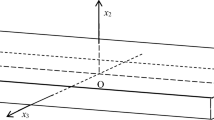Abstract
A rigid-plastic transversally isotropic medium with the additional kinematic assumption of inextensibility along the symmetry axis was examined as a model of a fibrous composite with a metal matrix. A complete system of equations for the axially symmetric deformation of such a body was obtained. In contrast to planar deformation examined in our previous work [5, 6], the axial symmetry problem is not locally statically determined, which prevents the separate analysis of the stress and velocity fields in the general case. The principal simplifications in formulating the equation system may be obtained for special cases of the stress state. One such simplifying assumption is extension of the axial conditions σr=σϕ or τrz=0 over the entire body. This hypothesis yields a separate system of equations for stresses. On the other hand, the common assumption of complete plasticity for an isotropic body when two principal stresses are equal does not provide fundamental simplification due to the lack of coincidence between the directions of the major stresses and the symmetry axes. An analytical solution was obtained for the axially symmetric problem of a plate with a round hole. A special feature of this problem is that the type of system of equations changes in the plastic region. The stress distribution in the circular hole was found to depend significantly on the type of equation system.
Similar content being viewed by others
References
R. Hill, Mathematical Theory of Plasticity [Russian translation], Mir, Moscow (1956).
V. O. Geogdzhaev, “Plastic planar deformation state of orthotropic bodies”. Tr. Mosk. Fiz.-Tekh. Inst., No. 1, 55–68 (1958).
D. D. Ivlev, Theory of Ideal Plasticity [in Russian], Moscow (1966).
I. T. Artem'ev, “Correspondence of two criteria of planar plastic anisotropy”, Izv. Ross. Akad. Nauk, Mekh. Tverd. Tela, No. 6, 142–147 (1992).
L. P. Isupov and E. A. Khlebalina, “Rigid-plastic model of a fibrous composite”, Mekh. Kompozitn. Mater.,30, No. 6, 730–736 (1994).
L. P. Isupov, “Equations for planar deformation of a plastic transversally isotropic body,” Izv. Ross. Akad. Nauk, Mekh. Tverd. Tela, No. 5, 102–108 (1995).
E. Spenser, Theory of Invariants [Russian translation], Moscow (1974).
B. E. Lobedrya, Lectures on Tensor Analysis [in Russian], Moscow (1986).
V. V. Lokhin and L. I. Sedov, “Nonlinear tensor functions consisting of several tensor arguments”, Prikl. Mat. Mekh.,27, No. 3, 393–417 (1963).
L. M. Kachanov, Fundamentals of Plasticity Theory [in Russian], Nauka, Moscow (1969).
V. D. Klyushnikov, Mathematical Model of Plasticity [in Russian], Izd. Mosk. Gos. Univ., Moscow (1979).
E. V. Lomakin and Yu. N. Rabotnov, “Elasticity theory equations for an isotropic heteromodular body”, Izv. Akad. Nauk SSSR., Mekh. Tverd. Tela, No. 6, 29–34 (1978).
Additional information
M. V. Lomonosov Moscow State University, Russia. Translated from Mekhanika Kompozitnykh Materialov, Vol. 33, No. 3, pp. 300–311, May–June, 1997.
Rights and permissions
About this article
Cite this article
Isupov, L.P., Khlebalina, E.A. Rigid-plastic model of a fibrous composite: Problems involving axial symmetry. Mech Compos Mater 33, 209–217 (1997). https://doi.org/10.1007/BF02256077
Received:
Issue Date:
DOI: https://doi.org/10.1007/BF02256077



